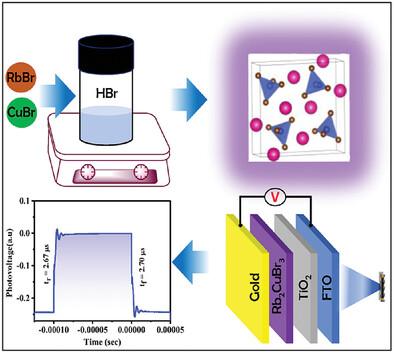用于紫外线光电探测器的无铅全无机卤化铷铜 Rb2CuX3(X = Cl、Br),响应速度快
IF 13
2区 材料科学
Q1 CHEMISTRY, MULTIDISCIPLINARY
引用次数: 0
摘要
最近,卤化铅包晶石在光电探测领域显示出巨大的潜力。遗憾的是,有毒铅元素的存在限制了它们的实际应用。在此,我们在酸性介质中成功合成了高质量的一维无铅晶体 Rb2CuX3(X = Cl、Br)。Rb2CuCl3 和 Rb2CuBr3 在 401 和 388 纳米波长处显示出紫色光致发光发射峰,激子寿命分别高达 12.78 和 59.67 µs,这是由于自俘获激子(STE)所致。此外,还利用 Rb2CuBr3 作为光吸收剂制作了一个光电探测器,用于检测有害的紫外线辐射。所提出的光电探测器的响应率为 0.92 mA W-1,比检测率为 1.57 × 109 Jones,上升/下降时间的快速响应速度分别为 2.67/2.70 µs。此外,这两种样品在露天环境和连续紫外线(254 纳米)下都表现出良好的稳定性,以及器件制造所需的良好热稳定性。因此,本研究表明,稳定、无毒、环保的 Rb2CuX3(X = Cl、Br)有望成为未来紫外线光电器件的候选材料。本文章由计算机程序翻译,如有差异,请以英文原文为准。

Lead-Free All Inorganic Rubidium Copper Halide Rb2CuX3 (X = Cl, Br) for UVC Photodetector with Fast Response
Recently, lead halide perovskites have shown great potential in the photodetection field. Unfortunately, the existence of toxic lead elements restricts their practical application. Herein, high-quality 1D lead-free crystals Rb2CuX3 (X = Cl, Br) are successfully synthesized in an acidic medium. Rb2CuCl3 and Rb2CuBr3 display violet photoluminescence emission peaks at 401 and 388 nm with a high exciton lifetime of 12.78 and 59.67 µs, respectively, which is due to self-trapped excitons (STE). Furthermore, a photodetector is fabricated to detect harmful UVC radiation with Rb2CuBr3 as a light absorber. The proposed photodetector has a responsivity of 0.92 mA W−1 and a specific detectivity of 1.57 × 109 Jones with a fast response speed of 2.67/2.70 µs for rise/fall time, respectively. In addition, both the samples show good stability against open air, and continuous ultraviolet light (254 nm), as well as good thermal stability which is necessary for device fabrication. Thus, the present study suggests that stable, non-toxic, and environment-friendly Rb2CuX3 (X = Cl, Br) can be a promising candidate for future UVC optoelectronic devices.
求助全文
通过发布文献求助,成功后即可免费获取论文全文。
去求助
来源期刊

Small
工程技术-材料科学:综合
CiteScore
17.70
自引率
3.80%
发文量
1830
审稿时长
2.1 months
期刊介绍:
Small serves as an exceptional platform for both experimental and theoretical studies in fundamental and applied interdisciplinary research at the nano- and microscale. The journal offers a compelling mix of peer-reviewed Research Articles, Reviews, Perspectives, and Comments.
With a remarkable 2022 Journal Impact Factor of 13.3 (Journal Citation Reports from Clarivate Analytics, 2023), Small remains among the top multidisciplinary journals, covering a wide range of topics at the interface of materials science, chemistry, physics, engineering, medicine, and biology.
Small's readership includes biochemists, biologists, biomedical scientists, chemists, engineers, information technologists, materials scientists, physicists, and theoreticians alike.
 求助内容:
求助内容: 应助结果提醒方式:
应助结果提醒方式:


